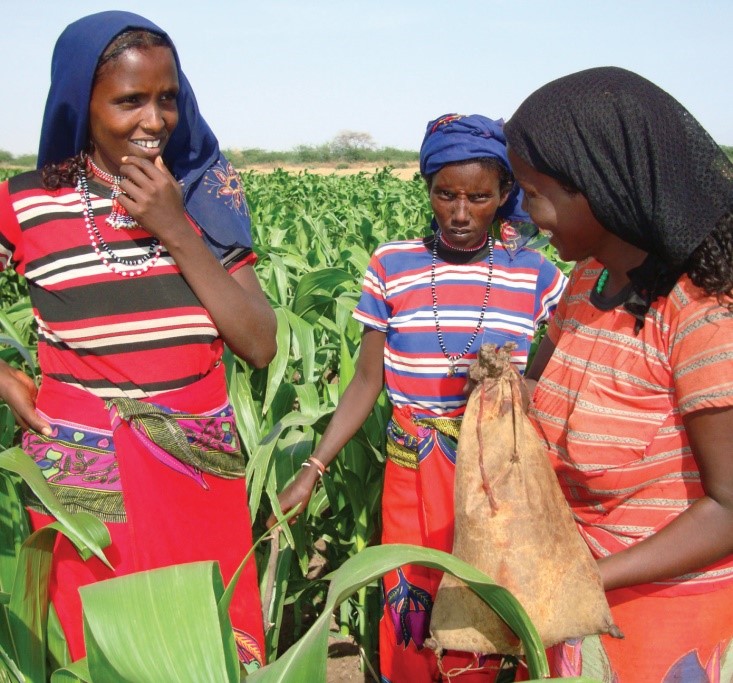Agricultural Economics
The agricultural economics research focuses on the generation of information and knowledge that enhance internal and external research efficiency, and on their dissemination to relevant stakeholders. Effort at enhancing the internal research efficiency is geared towards generating information that assists research agenda setting so that research priorities are demand driven considering the diverse agro-ecologies, production systems and markets in the country. Similarly, enhancement of the external research efficiency focuses on ensuring a rapid and widespread distribution of generated technologies that bring actual changes in the income and livelihood of their user through generation of information and knowledge on production economics, agricultural marketing, rural finance, rural community development and agricultural policy analyses. Currently the program is staffed with six PhD (one woman), 22 MSc (4 women) and 9 BSc holders based in 14 research centers throughout the county.

Lorem ipsum dolor sit amet, consectetur adipiscing elit. Ut elit tellus, luctus nec ullamcorper mattis, pulvinar dapibus leo.

Agricultural Economics
The
Agricultural Economics research focuses on the generation of information and
knowledge that enhance internal and external efficiency of the research system.
The outputs from Agricultural Economics provide evidences that assist research
agenda setting thereby making them driven by demands drawn from diverse
agro-ecologies, production systems and global/domestic markets.
On the other hand, the research findings from the program promotes the external efficiency by examining the enabling conditions in the external environment (Policy/ Development programs/ Institutions) for a rapid and widespread distribution and use of appropriate technologies developed by the research system. Consequently, the development of appropriate technology (internal efficiency) and the facilitation to remove potential barriers to distribution and use of these technologies (external efficiency) are expected to ensure access, availability, as well as faster and wider adoption of the technology by the farming community. This is believed to bring in favorable changes in productivity, income, and welfare of the producers and consumers which, in return, would also contribute to the macroeconomic goals of raising living standards and achieving stable economic growth.
The Agricultural Economics research pursues its purpose using the following five major research programs:
1. Agricultural Technology Adoption and Impact Assessment program,
2. Agricultural Market and Value Chain Analysis for High Value Commodities program
3. Agricultural Outlooks and Subsector Analysis for Strategic Commodities program;
4. Farming System Dynamics Program
5. Agricultural Production Economics and Efficiency Analysis program.
. Agricultural Technology Adoption and Impact Assessment Program,
Agricultural technologies, be it in the crop or livestock sector, even in any other knowledge products, is developed with ultimate users in mind. Technology development is not an end by itself, it needs to be applied and thereby generate certain utility/gains/returns to the users who have to make choices among options available to them. In this regard, the agricultural technology adoption and impact assessment program is designed to generate two sets of evidences that can inform both the research system and actors in policy and development domain.
The first one is related to technology adoption and involves efforts to deeply examine the level of use of agricultural technologies developed by the research system. In so doing, the program tries to dig out the drivers as well as the barriers to adoption and diffusion of those technologies among the target groups. Based on the evidence generated, it provides socio-technical feedback to the research system regarding the users’ perception, features (compatibility, relative advantage) and practical application of the technology in the socioeconomic realities of the user community. It also informs the actors in the policy as well as development domain regarding interventions required in unlocking institutional barriers to promote wider use of the technology.
The second one involves quantifying the value/gains of technology adoption received by the different decision making units including households and government. For technologies which are adopted by the target groups, the program assesses the level of actual impact (ex-post) both at the household as well as aggregate level such as regional and/or national economy; for technologies that are not yet introduced into the production system, the program tries to simulate and measure the potential impact (ex-ante) if the technology is adopted. The impact is often measured using indicators like productivity, income and other welfare indicators including poverty reduction, food and nutrition security. The evidences generated through impact assessment will be used to justify and indicate the worth of additional investment in research and development to scale up the access to and use of modern agricultural technologies.
- Agricultural Market and Value Chain Analysis for High Value Commodities Program
A value chain is a series of consecutive steps that go into the creation of a finished product, from its initial design to its arrival at a customer’s door. Each actor in the chain is expected to add value toward fulfilling the requirement of the end market customer. Value added implies both value creation and value capture. Since every strategically significant activity to be performed requires an investment in resources, it follows that each link in the chain is expected to add value. Likewise, a chain player’s ability to compete and succeed depends on its position along the industry chain, and how much value it is able to create and capture.
The Agricultural Market and Value Chain Analysis program focuses on understanding the behavior of different markets, analyzing the current state and proposing potential improvements of existing value chains. It involves the “mapping of the market” to track and analyze the contribution of the different chain actors and the relationships among themselves. An understanding of the interactions within a value chain helps identify the factors that influence how well or how badly the chain works.
The program, thus, generates evidences regarding the performance of the value chains of high value agricultural commodities along with challenges and opportunities; assess the role of collective actions in smallholder commercialization; and examine extent of market integration of major agricultural commodities. In so doing it tries to identify the production, market, institutional and policy related issues and suggest remedies to enhance supply of quality agricultural products for domestic and export markets.
Accordingly, the program helps to provide an evidence based recommendations for interventions that policy makers as well as market and development actors need to pursue to upgrade the current value chain as well as ensure markets to function in the most optimal ways (external efficiency). Also, it provides marketing signals for various products and informs the research system to develop technologies (internal efficiency) that can respond to the consumers’ demand both in quality and quantity.
- Agricultural Outlooks and Subsector Analysis program
The potential impact of a given research investment can be increased if we initially employ a strategy for setting research priorities that increases the likelihood that the research program addresses major problems constraining the supply of or the demand for a major commodity and generates technologies that will be widely adopted. This involves not only organizations or firms, but all the ways (rules, law, and business practices) that helps those organizations coordinate a vertical set of activities from input supply to consumer. Beyond a horizontal coordination where farm level interactions across enterprises are examined, a growing economy attracts vertical integration across actors operating in a complex food system where for each commodity there exists various productions, distribution and coordination functions.
The agricultural outlook and subsector analysis program helps to systematically understand future outlooks, economic significance, and opportunities for competitiveness of strategic commodities in light of prevailing comparative advantage. Subsector analysis is an approach born of the need to develop a mechanism that can take into account key interactions within the food system by looking into the changes observed in the technological, institutional and/or policy dimensions. The foresight analysis, on the other side, helps to predict how the demand and supply of key commodities respond differentially over space and time relative to different pressures or interventions. It involves identifying trends, drivers of change, and potential scenarios that could impact the subsector in the future.
Accordingly, the program is designed to document the current status, opportunities, and challenges, and to analyze future outlooks in terms of input use, production, marketing, consumption, export, and provide timely information to researchers, stakeholders, and policymakers to contribute for improvements of key strategic food security, agro-industrial, and export commodities. In so doing the program informs the research system to establish initial research priorities (internal efficiency) and to the development and policy domain to set up interventions that can either correct irregularities along the vertical integration or maximize the future benefit of a well-coordinated system (external efficiency).
- Farming System Dynamics Program
Developing appropriate technologies in small-holder dominated production system where diversification is more prominent practice than specialization demands looking at the horizontal interactions between various enterprises at farm level. In light of changing national and global environment, particularly climate change, research and development efforts need to respond to the needs arising from the emergence (exclusion) of new (existing) commodities. Over the last several decades a number of production technologies (varieties, breeds and practices) were introduced to different farming systems, yet the question why most farm household remain vulnerable and not as productive as expected remains unaddressed.
The farming system and dynamism program is designed to characterize and understand the existing production systems and their interactions, monitors new developments and changes observed in the traditional farming system, and identify the prevalent constraints/ opportunities that limit/ remain untouched in the effort to improve the performance of the prevailing production system. In addition, it investigates adaptation and coping mechanisms, mitigation and extent of resilience of the farm households to climate change and tracks responses of the different farming systems to existing agriculture related policy directions.
The program integrates both biophysical and socioeconomic issues and measurements for better understanding of the farming systems at different agro-ecological conditions. It provides evidences that help the research system to gauge its priorities based on production constraints/ opportunities observed along with the changes and dynamics in a particular farming system (internal efficiency). Moreover, the information generated by the program is useful to promote system sustainability, better livelihoods and relevant interventions/ development initiatives that work well under complex production system (external efficiency).
- Agricultural Production Economics and Efficiency Analysis program
Technological changes may not be the only source of growth in productivity. Farmers can also attain higher return on costs incurred for production through optimal allocation of available resources. In addition, higher returns due to technological changes needs to be justified based on the cost involved.
The production economics program focuses on improving the profitability of smallholder farmers by generating pertinent information on ways to improve the efficiency with which factors of production are combined and utilized. The program applies economic theories and range of analytical models to determine efficient level of resource use among the many possible combinations of key factors of production (land, capital, labor, entrepreneurship).
The program also provides information for commercially oriented productions regarding the profitable combination of enterprises (crop and livestock) and the scale at which the production remains competitive. In an effort to minimize the cost of production, the production economics program examines the cost structures and identify intervention area for cost reduction thereby guides investment decisions on technological transformation.
In the event of new technologies entering into the production system, the program evaluates the comparative advantage of the new technology/practice against existing practices.
The program envisages promoting commercialization of the agriculture sector by generating up-to-date information on economic efficiency, cost of production as well as competitiveness and comparative advantage of strategic commodities. Thus, it is designed to provides evidence based recommendations for producers (small/large), development partners and policy makers on mechanism of efficient resource utilization to maximize returns from available endowments and remain competitive (external efficiency), on the one hand, and feedback into the research system regarding ways to improve the profitability and cost effectiveness of new technologies and practices (internal efficiency), on the other.